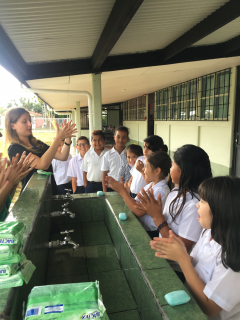San Vito, Costa Rica
Rural Primary Care
March 21-April 27, 2018
I spent six weeks in San Vito, Costa Rica, from March 21-April 27, under the supervision of Dr. Pablo Ortiz. I rotated through three different primary care clinics in and around the San Vito area, observing and assisting during patient visits. I also participated in health screenings and health classes at local elementary and middle schools. Living in Dr. Ortiz’s house in San Vito, I also had the opportunity to discuss the Costa Rican healthcare system with Costa Rican medical students, residents and public health professionals.
Costa Rica has a universal healthcare system, where all services in public clinics and hospitals are free of cost for all residents. However, in poorer areas, many of the medical centers have limited resources in terms of clinic equipment and medical services available to the population. In this elective, I rotated through 3 local primary care clinics with the Costa Rican medical students. Mostly, I observed patient appointments and was able to discuss some differences in standards of care and practice. I also helped to conduct health screenings and educational sessions at local public schools. My main goals for this elective were learning about the Costa Rican healthcare system and improving my medical Spanish.
I spent the majority of my time at the clinic in La Casona, where the vast majority of patients are part of the indigenous Ngobe population. This population consists of approximately 11,500 people who have retained much of their traditional culture and way of life, including their spiritual beliefs and clothing. This is a very poor and under-resourced population, and many patients walk hours to get to the nearest medical clinic. This clinic, where I worked, has only one doctor and one nurse who see patients Monday-Friday. Often, there are patients who walk to clinic for an urgent appointment, and wait all day in the hopes that the doctor can squeeze them into his always packed schedule. 1-2 days a week, the doctor and nurse may be assigned to smaller clinics in even more isolated communities, and on those days La Casona clinic is closed completely. Ambulance and paramedics are another limited resource. There is only one ambulance available to pick patients up from La Casona clinic if there is ever an emergency. This ambulance covers a wide region, and once our patient with possible traumatic brain injury from a fall had to wait 4 hours for the ambulance to arrive. The ambulance arrived only with a driver, so the patients’ parents monitored them in the back of the ambulance for the 40-minute drive to the hospital. These were concerns that were also brought up at a community meeting with local officials. I was able to discuss these topics with Dr. Ortiz, who had some insight into why these gaps in care exist and who would have the power to make these needed changes.
This experience definitely met my learning objectives. I had the opportunity to learn about the Costa Rican healthcare system from speaking to Dr. Ortiz and the Costa Rican medical students I lived with. Additionally, I learned a lot first hand from the clinic appointments I observed, as well as the community outreach health screening and educational programs I participated in. The best aspect of the experience was definitely the people I had the chance to meet. Dr. Ortiz’s house always had visitors. I met a family medicine resident from Spain, a family medicine doctor and public health professionals from Chile, and medical students from the Britain, just to name a few. It was very interesting discussing perspectives on health disparities in Costa Rica as well as our respective countries. One of the obstacles I encountered was that our house was accessible only by car, and the cars available were both standard shift cars, which I cannot drive. Luckily, the Costa Rican medical students I lived with were very friendly, and I was able to commute with them or get a ride from them if I ever needed to go to town.
The advice I have for future students is just to go in with an open mind. There is so much to learn there, and almost everyone I met was excited to discuss the healthcare and culture in Costa Rica. Living in Dr. Ortiz’s house in San Vito also requires an adjustment compared to life in NYC. You are less independent, especially if you cannot drive standard shift cars, and also you share space with several other students. It is really helpful to read reflections from other students to get an idea of what it is like to live there. Also, would be helpful to brush up on Spanish skills!


